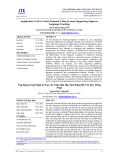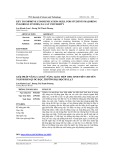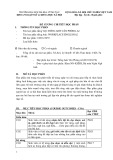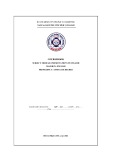
(1+1&,17+(())(&7,9(1(662),17(535(77,21
35&7,&(7+528+528335(6(177,21
1HQ7KL4QKRQ
3KDP7KLHQ
Email:quynhhuong138@gmail.com,pthien@uneti.edu.vn
Received:05/08/2024
Revised:17/02/2025
Accepted:26/02/2025
DOI:10.59266/houjs.2025.536
EVWDFW Translation can be considered the fth special skill - an advanced skill
WRHWKHLWK R VLVKV LPSRLQDQG SDWLLQWKLV VLSDVD LDSDW LQ
teaching translation and interpretation majors. Up to now, not many studies have been
DLHG RW RQ HQKDQLQ LQWHSHWDWLRQ SDWLH WKRK PDLQ RS SHVHQWDWLRQV
Thisarticle,asaresultofresearchconductedduring8weeksinthe2
QG
term(2023-2024),
showslearners’improvementinvocabularyandexpression,togetherwithequivalenceand
using body language in interpretation practice. The method mainly relies on qualitative
methods,includingtheteacher’sclassroomobservation,note-taking,andlearners’surveys.
Thendingsareexpectedtoenrichteachingmethodologyforthosewhoareinchargeof
LQWHSHWDWLRQRVHVLQWDLQLQ(QLVKPDMRVDWQLHVLWLHV
.HRV
enhance,eectiveness,practice,interpretation,grouppresentation.
HoChiMinhNationalAcademyofPolitics
UniversityofEconomics-TechnologyforIndustries
,,QWURGFWLRQ
While atranslationcourserequires
ODUQUV R RFV PFK RQ UDLQJ DQ
writing skills, an interpretation course
demands to concentrate heavily on
listening and speaking skills. Regarding
interpretation, time pressure to express
KVSDNUVVSFKLQDRULJQODQJDJ
SUFLVODQLPPLDOLVKSULPDU
requirement. In fact, there are many in-
class activities, such as role-playing
(speaker, interpreter, assessor, audience),
individual working, pair working, and
group working, enabling students to
improve their interpretation skills. This
articlerevealsthendingsofresearchon
improvinginterpretationpracticeinclass
through group presentations for nal-
DU (QJOLVK PDRU VQV VSFLDOLLQJ
LQ UDQVODLRQ DQ LQUSUDLRQ D K
UniversityofEconomicsandTechnology
for Industries (UNETI). The research
heavily relies on qualitative methods, in
which teacher observation, note-taking,
andsurveyonlearners’opinions,aswell
as test results, are conducted during the
FRUV LQ K
Q
semester (2023-2024).
The eectiveness of group presentations

FDQ E VQ LQ VQV SURJUVV LQ
linguisticandinterpretingcriteria.
,,/LWHUDWUH5HYLH
2.1. Denition and characteristics
ofinterpretation
The Cambridge Dictionary denes
LQUSUDLRQDVFKDQLQKDWVRPHRQH
LV VDLQ LQWR DQRWKH ODQDH
(dictionary.cambridge.org/dictionary/
English/interpreting). Pochhacker
(2007)identiesLQWHSHWLQ LV RP R
translatinginwhichrstandnalrendition
LQDQRWKHDQDHRDQWWHDQHLQD
VRH DQDH”. Similarly, Christoels
and Groot (2005) state, LQWHSHWLQ LV
a complex task where the interpreter is
RWLQH LQRHG LQ RPSHKHQGLQ
bringing,andproducingstyleatthesame
WLPH In the denition, the scholars
indicatespecialfeaturesofinterpretation,
suchasspeakingmode(saying,utterance)
RKDKKDUDQLPSUVVUDK
VDPLPRUQDUODKVDPLPDVK
speaker). They also mention the process
and procedure, including understanding,
processing, and producing the style
VLPODQRVO ULQJ K VSDNUV
speech. Based on these characteristics,
a very close relationship exists between
speakingandinterpretation.Accordingto
Ur(2000),speakingisthemostessential
LQDFKLQJDQODUQLQJDODQJDJDPRQJ
thefourskills.Surely,interpretationmust
cover many factors, and speaking plays
themostimportantpart.
2.2. Denition and characteristics
ofpresentation
AccordingtotheOxfordDictionary,
presentation is dened as‘KH LLQ R
VRPHWKLQWRVRPHRQHHVSHLDDVSDW
RDRPDHHPRQDQLQKNLQR
DQRQVSHHKRWDLQKLKDQH
SRGW LGHD RSLHH R R LVVKRQ
and explained to an audience’. Thus,
SUVQDLRQ FDQ E QUVRR DV K
abilitytodeliverinformationcondently
and persuasively to engage and
inuencetheaudience.Inapresentation,
informationisconveyedfromspeakersto
audience and it is typicallyintroduction,
demonstrations, a speech or a lecture
withtheaimtoinform,inspire,persuade,
buildgoodwill,motivate,orpresentanew
ideaoraproduct/service.Atuniversities,
presentationiswidelyapplied,especially
in language classes. Barbara Gross
(1993), in RRV R HDKLQ VUVVV
KD SUVQDLRQ QDEOV ODUQUV R
VPRUDQPPRULORQJUKDQRKU
teaching tools. Moreover, applying in-
classpresentation,asconcludedbyApple
& Kikuchi (2007), creates opportunities
RUODUQUVRVKRULJQODQJDJLQ
themostnaturalway.
2.3.Criteriatoassessinterpretation
As discussed above, speaking
SODV DQ VVQLDO URO LQ UDQVUULQJ
K VSDNUV VSFK URP RQ ODQJDJ
to another. So, referring to the criteria
to evaluate interpretation cannot help
mentioningcriteriatoassessspeaking.In
Hieke’sopinion(1985),thefourcriteriaof
speakingevaluationincludetheabilityto
usevocabulary,theabilitytopronounce,
grammar accuracy, uency, and
RKHHQH.Indetail,hesuggeststhatthe
abilitytousevocabularyisresortedtothe
DSSURSULDRUVLKKFORVVPDQLQJ
to the speaker’s intention. At the same
time, pronunciation covers pronouncing
vowelsandconsonantscorrectly,aswell
as sentence stress and intonation. The
FULULRQRJUDPPDUDFFUDFLVDVVVV
via sentence structures and exibility of
usingbothsimpleandcomplexsentences.

Incontrast,uencyistheabilitytospeak
English easily at the average speed of
native speakers. Together, uency and
FRKUQ SUVVLRQ DU RKU LPSRUDQ
DFRUV LQ PRQVUDLQJ D VQV
speaking level. A good speaker needs
to have clear ideas and know how to
link those ideas together. To ensure
that, students need to clearlyunderstand
FRQQFLQJ RUV DQ NQR KR R V
them uently in the communication
process.Whenlearnersareabletoexpress
themselves coherently, their speaking
levelwillincreasesignicantly.
In the study on developing a scale
RU DVVVVLQJ QUJUDD VQV
consecutive interpreting conducted
on Korean students, Lee, S. B. (2015)
reviewed42criteriatoevaluateinterpreter
SURUPDQF QU KU FDJRULV
RQWHQW RP DQG GHLH DQ
shortlisted into 22 criteria, in which
seven criteria for content, seven for
form,andeightfordelivery.Inaddition,
a questionnaire survey was conducted
RQ LQUSUU UDLQUV R LQL K
DSSURSULDQVV R LJKLQJ RU DFK
category. He concludes that the RQWHQW
category shouldbe assignedan eective
HLKW R KLH WKH RWKH DWHRLHV
need not be weighted (i.e., weighting
value: 1). At UNETI, the criteria of
evaluating consecutive interpretation are
EDV RQ LQLVWL LJK SRLQV
(pronunciation, vocabulary, grammar,
and sentence structure) and LQWHSHWLQ
LWHLD weighted 7 points (equivalence,
naturalness, speed and response, non-
verbalcommunication,andcompleteness).
,,,0HWRGV
7K SUVQ V UVRUV K
mixed method, in which qualitative
PKRV LQFO K DFKUV FODVVURRP
observation, note taking, feedback, and
the survey on learners’ opinion. The
quantitativetechniquescomefromgiving
PDUNV DQ VDLVLFV URP K VQ
survey. Before conducting the study,
the teacher evaluates via a pre-test in
consecutive interpretation and the post-
test at the end of the course. The same
V DV DSSOL RU VQV DV K SU
testandpost-test,whichwasthevideoof
CNN news on 07 Feb 2024, ‘&DLRQLD
agreeson$2Bsettlementforstudentshurt
byCovidshutdown’onyoutube.comCNN
10. The video includes talks and short
interviews, while the news onVTV1 on
KVDPDEDVFKRVQ
astheVietnamese-Englishone.7KLP
VSDQ EQ K SUV DQ SRVV
waseightweeks.
7K JURS SUVQDLRQ DVVLJQPQ
is given at the beginning of the course
‘AdvancedTranslationandInterpretation
inUse’sothattheycanpreparewell.Each
JURSFRQVLVVRVQVRUPRQ
theirownchoice.Thetopicsforpresentation
DU VLDEO LK KRV PRQVUD LQ
thecoursebookcurrentlyused,including
RSLFVLWH(GDWLRQHQGH
equality,Healthcare,Festival,Economy,
Environment, Hi-technology, Transport,
SRWV (PSRPHQW DQG &WHV 7K
RSLF FKRVQ E K DFKU LV DVVLJQ
RQO D N RU SUSDUDLRQ ERU K
SUVQDLRQ VR KD K SUSDUDLRQ
time is equal among groups. After the
presentation, each group had to collect
words/phrases related to the topic into a
glossaryandsharethemwithothergroups.
7K SUVQDLRQ PV E RQ
PowerPoint slides and delivered for
approximately 30 minutes. The aim
LV R SUDFLF (QJOLVK 9LQDPV
and Vietnamese - English consecutive
interpretation. The requirements include

choosing a speech (video preferentially)
ofthegiventopic(5-7-7-minutelength)
on the B2-C1 level and performing
interpretation. The speeches with video
VOFRUKSUVQDLRQDUJDUDQ
the naturalness of the originallanguage.
7KD PDQV K (QJOLVK9LQDPV
LQUSUDLRQPVEVSRNQE(QJOLVK
nativespeakersandtheotherVietnamese
-EnglishperformedbyVietnamesenative
ones.Eachgroupmembermustspeakoutin
thepresentation.Studentshavetointerpret
everysmallparagraphof3-4sentences/a
pause. At the end of the presentation, a
JDPRUTLRQKRSLFVPPDUVKRO
bedoneasanadvantageandaplusforthe
group.Theresearchlasted8weeks,from
earlyFebruarytolateMarch2024,infour
classesDHNNA14A1-A4HN,withatotal
of179studentsontheB2-C1level.
7K DFKUUVDUFKU QRV KU
observationsoneachgroupandmember.
Attheendofeachgroup,theteachergives
feedback, and the classmate’s comments
andmarksaregiven.Theteacher’snotes
follow the two criteria of evaluation at
UNETI: linguistic criteria(3 points) and
interpretationcriteria(7points),shownin
detailinTable1.
Table1.CriteriaforassessinganinterpretingtestatUNETI
&RPSHWHQFH HWDLOHGFULWHULRQ 6FRUH
DQJDJ
FRPSQF
Pronunciation,voice,andtone
Vocabulary,grammar,expressions
Interpreting
FRPSQF
Equivalence
PurelyVietnameseorEnglishstyle(naturalness)
Paceofdelivery 0.5
Interpretationstrategiesandbodylanguage
Completeness 0.5
7RDO
(Source:FacultyofForeignLanguages,UNETI)
Inthisstudy,‘interpretationstrategies’
and ‘completeness’ are excluded because
allofthestudentshavefullledtheirtask,
and‘interpretationstrategies’areembedded
in ‘equivalence’. Also, a survey of nine
multiple-choice questions about uency,
speed,coherence,response,abilitytouselong
sentences, and non-verbal communication
wasconducted.Thequestionsaredesigned
onGoogleFormsanddeliveredattheendof
thecourse,afterthegrouppresentations,and
afterthepost-test.
,9)LQGLQJVDQGGLVFVVLRQ
4.1. Group observation, note-
taking,feedbackfromtheteacher
/DQDHLWHLD
The students showedtheir creativity
andintelligenceintheirpresentations,which
surprised the teacher. The speeches with
videomainlycomefromveryupdatedand
reliablesourceslikeCNNorBBCinEnglish
and VTV1 in Vietnamese. Especially,
K QDPLOLDU DQ FKDOOQJLQJ RSLFV R
agriculture, environment, health-care, or
gender equality,… students prepare very
well,notonlypresentingtheirinterpretation
skill, but also providing knowledge for
audience. For example, on the topic of
agriculture, students wisely choose the
top tenoutstandingeventsof 2023shown
on VTV1 end-of-year news, in which
9LQDPV DJULFOU LV VR EULJK LK
manyachievementsintheglobaleconomic
recessionaftertheCOVID-19pandemic.
7K VQV SURQQFLDLRQ DQ
intonationgenerallyprovequitegoodwith

correct word stress and sentence stress.
However, some members make errors
whenpronouncingdicultwords/phrases,
VFK DV patient, capacity, distribution,
equality, patriotism, tax incentive,
GHRHVWDWLRQ HQLRQPHQWD LHQG
categorization,racialdiscrimination,etc.,
orsomestudentsuseaatintonationand
monotonousvoice.Raisingupandfalling
downintonationwassometimesmisplaced.
Thevocabularyismainlyacademic,witha
neutraltoneandformalstyle.Therewere
stillsomeerrorsinverbusewhichisoften
confusing,suchasRDQGRPHHQG
and ‘borrow’, ‘make’ and ‘do’, ‘bring’
DQGWDH,orsomecommoncollocations
VSRNQ E9LQDPV SROLLFLDQV VFK DV
‘ansinhxãhivphúclixãhi’,(social
security and social welfare) ‘lm đ ăn’,
(income and expense balance), ‘cung đ
cầu’ ( suppliesmeetdemands),...In terms
ofverbtenses,learnerstendedtousepast
VLPSOLQVDRSUVQSUFRLQUSU
the word ‘đã PE LQ 9LQDPV
VQQFV KRJK K DFLRQ KDV ODV
to the present. Sometimes, they made
mistakeswiththeprepositions‘VLQHDQ
‘RPandusedboth‘DWKRKand‘but’,
both‘because’and‘VRLQDVQQFR
negativetransference.Themistakesinthe
OLQJLVLF DVSFU USRU ULJK DU
D SUVQDLRQ E K DFKU VR KD K
JURSLVODQKROORLQJJURSVFRO
avoidthem.Oneremarkablethingwasthat
thelatergroupslearnedfromtheprevious
ones’errorsandadjustedpromptly.
Interpretationcriteria:
In general, students usually
SURUP (QJOLVK 9LQDPV
interpretation more uently than
Vietnamese - English one. The learners
felt more condent and easier to utter
ORQJU VQQFV LQ 9LQDPV KDQ LQ
English.However,somespecializedterms
also generated challenges for students,
like ‘market segmentation,’ ‘global
recession,’ economic crisis,’ ‘sexual
harassment behavior,’ embarrassment,
HHQKRVHHPLVVLRQLQHDVLQDLQ
population,’ ‘being redundant,’ over-
RRDGIt took them timeto nd out
the equivalence in Vietnamese (phn
đoạn/phnkhúcthtrường,suythoiton
cầu, khng hoảng kinh tế, hnh vi quấy
rối tnh dục, khí thải nh kính, gi ha
dnsố nhanh, b mất vic, qu tải vic
lm...).Somestudentssawdicultyand
KVLDLRQ LQ LQUSULQJ (QJOLVK QRQV
formed from verbs into Vietnamese by
choosing the wrong word of category,
e.g.economicHRHsphụchồikinh
tế), the VWQH RU RPQV TDOL
cuc đấu tranh giành quyền bình đẳng
của phụ nữ), conservatively traditional
WKLQLQ lối suy nghĩ truyền thống bảo
thủ), the authorities’ problem-VRLQ
cchgiảiquyếtvấnđềcủacácnhàcầm
quyền)... Sometimes, the phenomenon
R OLQJLVLF UQDQFV DV KDU E
VQV KQ K LQUSU (QJOLVK
complexsentenceswithrelativepronouns
LQR9LQDPVKHVSHSRHQDWLRQV
KR WDH RQWR RHWKH RG WDGH
balance...)ortransferredpassivevoicein
EnglishintoactivevoiceinVietnamese(It
was believed that...). These expressions,
more or less, aected the naturalness of
theirinterpretation.
Mostofthestudentshadquitegood
preparation and good memory, so they
delivered the presentation at amoderate
pace;justafewofthemspokequitefast.
Usually, when interpreting gures and
propernames,thestudentstendedtoslow
RQKLUVSFKRUVKRUSDVVLQKLU
expression. In terms of interpretation
strategies, there was not much specialty
apartfromliteralandsemanticstrategies.
However, body language used by the
ODUQUVQREPQLRQKQK
earlygroupsfacedtheirsmartphones,not
lookingat the audience.Anotherremark
OD LQ KLU DFLDO SUVVLRQ DQ












![Tài liệu Từ vựng tiếng Anh Trung cấp [mới nhất]](https://cdn.tailieu.vn/images/document/thumbnail/2025/20250913/nguyentuan250421@gmail.com/135x160/99491757910839.jpg)
![Tài liệu Từ vựng Tiếng Anh theo chủ đề [mới nhất]](https://cdn.tailieu.vn/images/document/thumbnail/2025/20250913/namdhuet@gmail.com/135x160/83251757753810.jpg)



![Tài liệu Từ vựng tiếng Anh cho bé [chuẩn nhất/mới nhất]](https://cdn.tailieu.vn/images/document/thumbnail/2025/20250731/huadaithesang2509@gmail.com/135x160/18631754013896.jpg)








